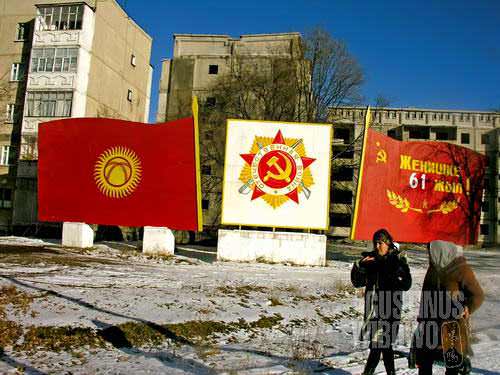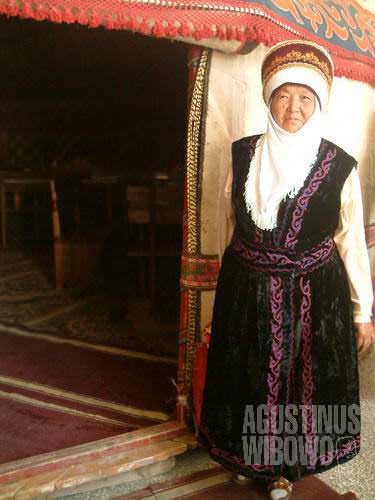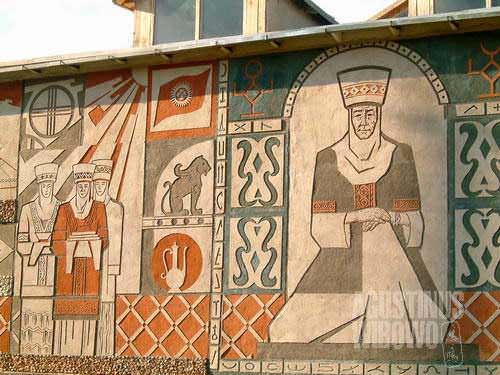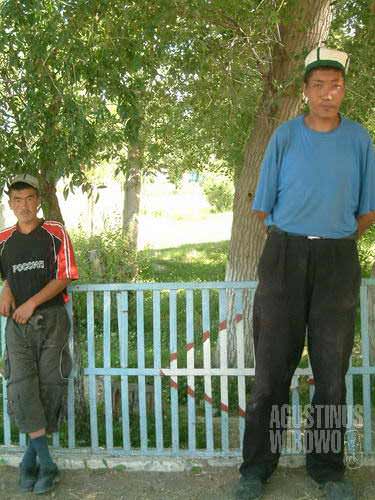Toktogul – The Kyrgyz Language
It is the first chance for me to get acquainted with one of the Turkic languages. Kyrgyz, as well as Kazakh, Uzbek, Turkmen, Turkish, and Mongol are Turkic languages. The first five are quite close each other, but Mongol is completely intelligible to other Central Asian Turkic speakers. Some linguists put Korean and Japanese in the Turkic language group, due to similarity of word order and agglutinative verbs. But newer linguistic classification, as what I believe, has thrown away the two Oriental languages out of the group.
Before getting confused, please notice the difference between ‘Turkic’ and ‘Turkish’. The Turkic languages family is a group of languages with similarities of grammar and word forms, which includes Turkish and most of Central Asian languages.
Books for learning Kyrgyz in English language are quite difficult to find even in Kyrgyzstan, and I was lucky that I met two Peace Corps volunteers who lent me the grammar book. For me, Turkic language experience was very fascinating, full of formulas, and I read 100 pages of grammar rules in 2 nights, and used to wake up full of linguistic formulas in my head.
The Turkish languages have similar word order: S-O-V. The languages are agglutinative. And there is very important characteristic that neither Japanese nor Korean posses: vowel and consonant harmony.
As I am also a beginner, let me introduce some interesting features in Kyrgyz language. Kyrgyz and Kazakh are extremely close dialects, in Altai group of Turkic family, being elevated to separate languages to promote the definition of ethnics in central Asia by the Soviet Union. In fact the definition of Kazakh and Kyrgyz was very confusing. The Kazakh was called previously as ‘Kyrgyz’ to differ them from the Cossacks. Consequently the Kyrgyz was called as ‘Kara Kyrgyz’ or ‘the black Kyrgyz’ to differ them from Kazakhs who was named as ‘Kyrgyz’. Now as new nations were created, new nationalism concept should be established. Minor variations are fixed to be ‘national identity’.
We can see this phenomenon in the languages. Both of Kazakh and Kyrgyz use the Cyrillic alphabets. Both have their ‘own’ alphabets that are not shared with the Russians, like the letter Θ and Y. The Kazakh also has Cyrillic letter ‘i’ which doesn’t exist in Kyrgyz. Now on, dialects were elevated to be different languages, as well as ethnic variations which get promoted to be independent nations.
People see the name of the country, Kyrgyzstan, is very difficult to pronounce, as it is a long word with only one vowel. In fact, ‘y’ in Kyrgyz language, written as ы in Cyrillic, is a vowel, and is in pairing with vowel ‘a’. ‘y’ in Kyrgyz is pronounced like ‘eu’ in Indonesian word ‘keukeuh’. So now you know how to pronounce ‘Kyrgyzstan’ properly.
Vowel pairing is characteristic of vowel harmony, which as stated before, is the main feature of Turkic languages. All vowels in a word (a native word, not an imported one) should be from the fixed pairs. The sets of vowel pairs in Kyrgyz are:
‘a’ is in pair with ‘u’ and ‘y’
‘o’ is in pair with ‘u’
‘e’ is in pair with ‘i’
‘ö’ is in pair with ‘ü’
These sets of vowel pairs are unique for Kyrgyz and might be false for other Turkic languages.
Now let’s see some place names in Kyrgyzstan. The name of the country consists ‘a’ and ‘y’ vowels, which are in pair. Notice other names like Yssyk Kul (Warm Lake), Sary Tash (Yellow Stone), Jalalabad, Özgön, Naryn, Toktogul, Tokmok, and Kyzyl Art (Red Back). All of these follow vowel pair rules explained before. This also works fro Kyrgyz native names and words.
Some Arabic words, which came together with Islam about 500 years ago, had to adapt to this rule of vowel pairs. The Kyrgyz call ‘nikah (wedding)’ as ‘nikeh’, ‘masjid (mosque)’ as ‘mejit’, and ‘kitab (book)’ as ‘kitep’. The recently borrowed Russian words in fact came in stronger power and influence, and most all of them still retain the original Russian form and don’t obey the Kyrgyz vowel rules, like ‘vokzal (station)’, ‘pochtamt (post office)’, and ‘mashina (car)’.
In some extent of the languages, we can see that Islam, thus Arabian influence sphere, never been too strong here. If the Uzbek considered ‘assalomualaikum’ as Uzbek greetings, the Kyrgyz rarely use this greetings and it is addressed to respected men only. The normal greetings are ‘salamatsyzby (‘are you fine?’, notice all of the vowels), then continued by asking whether the person’s husband or wife, children, family, animals, house, yurt, are all fine. This reflects the life of their nomadic culture.
Back to the grammar, the vowel harmony is very important when words are formed. As an agglutinative language, words are formed through affixation process, mostly suffixation. My mother tongue, Indonesian, is also an agglutinative language. Indonesian prefixes and suffixes might be very complicated, but we only have consonant harmony and no vowel harmony. Kyrgyz only has suffixation but both of consonant and vowel harmony. The suffix also has to follow the rule of vowel pairs and might be complicated when there is choice of ‘right’ or ‘left’ vowels. This makes beginners, like me, have to draw the formulas of word forming beofe being able to make every single word.
For example, Kyrgyz has many endings to make plural nouns: lar, lor, ler, lür, tar, tor, ter, tür, dar, dor, der, dür. Which ending to be used depends on what vowel and consonant exist at the last syllable of the word. It is the reason why ‘alma (apple)’ becomes ‘almalar (apples)’, while ‘gul (flower)’ becomes ‘guldor (flowers)’ and ‘kitep (book)’ becomes ‘kitepter (books)’.
The concept of consonant harmony, if you know basic grammar of Indonesia, is similar on how our prefix ‘me’ changed to be ‘meny’ in ‘menyapu’ and ‘mem’ in ‘membantu’. We don’t have vowel harmony in Indonesian, otherwise we would have imaginary words like ‘manyapu’ and ‘mambantu’.
Like Indonesian, Kyrgyz makes their plurals, nouns, verbs, or anything you can imagine with the assistance of affixation (the characteristic of agglutinative languages). But for me personally, Kyrgyz affixation is more complicated as there are 4 pairs of vowels, two groups of vowels (left and right groups), two groups of consonants (weak and strong), 8 pronouns (of which each has its own endings for verbs), tenses (present, past, continuous, perfect, etc), and negation (‘no’ in Kyrgyz is reflected by a suffix followed by personal ending).
These language rules, as well as the history, connected the ethnic with the Turkish, who live thousands kilometers away at the frontier of Europe continent. Language is culture. It is also mental scope. Turkey is one among the countries which seek hegemony in Central Asia after the independence of the new Turkic speaking nations (Azerbaijan, Kazakhstan, Kyrgyzstan, Uzbekistan, and Turkmenistan). You may see many Turkish funded universities in many cities in Kyrgyzstan which also allow Turkic speakers from other countries to get scholarship program, like the Uzbeks from Afghanistan and Uyghurs from China. The result of these is more and more young Kyrgyz and other Central Asians speak proper Turkish.
Persian language was language of culture and high court in Central Asia in the past (like French in 18th century Europe) but now Persian is dominated by the Turkish. The Persian speakers only left in Tajikistan and some cities of Uzbekistan. It is also has something to do with the arrogance of the Iran towards the Sunni Persian speakers, making the Turkic hegemony stronger even in Persian-speaking Tajikistan. But how deep is the Turkish hegemony among the Turkicized people of Central Asia, for example in Kyrgyzstan? It is still nothing compared to the Russian influence, due to a century under Soviet Union. In Bishkek, people speak Russian each other, even between the Kyrgyz. The recent president was forced to change the constitution to put the Russian language a higher position making it comparable to the Kyrgyz language. The language nationalization programs, which was supposed to boost Kyrgyz language as a proud national language, was not efficient due to lack of infrastructure and basic fundaments in their own language. The programs included ‘Romanization’ of the Cyrillic alphabet and force all officers to speak Kyrgyz properly at work despite that all higher education institutions teach in Russian.
Once, a Turkish Prime Minister visited Kyrgyzstan after the independence to gather more support from the ‘east’. A Kyrgyz poet delivered him a poem symbolizing Turkey’s disorientation from ‘west’ to the ‘east’.
You left (Central Asia), on a horse, with black eyes
Now you come, by airplane, with blue eyes
Few regarded this as a compliment.















Leave a comment